Stevenson J. Power system analysis
Подождите немного. Документ загружается.

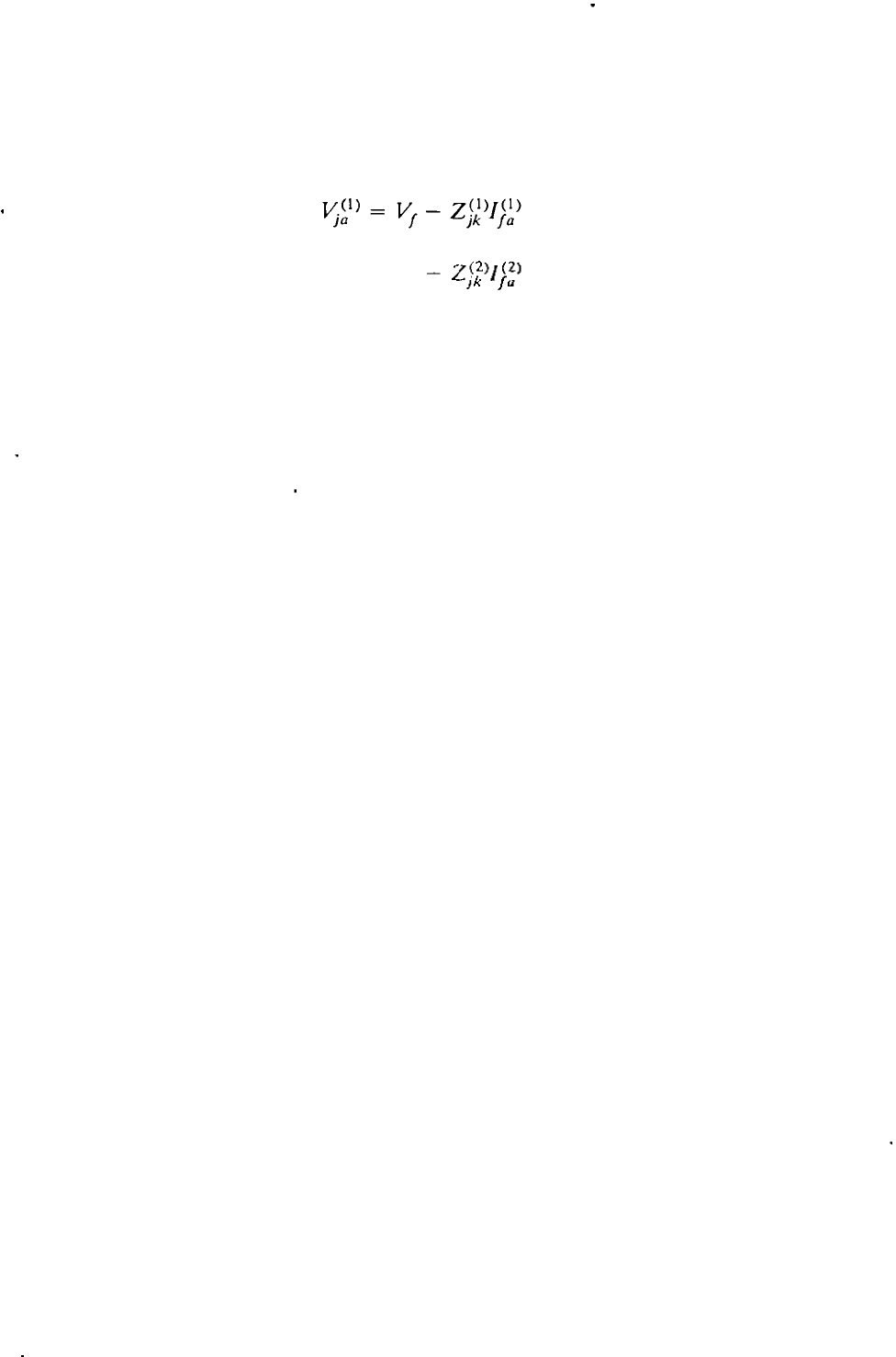
476 CHAER 12 UNSYMMETRICAL FAULTS
at bus
®
the voltages at any bus are
v
(O
)
=
Ja
V(2) =
Ja
-
Z
(O
)
/
(O
)
j
k fa
(12.6)
If the prefault voltage at bus is not Vf ' then we simply replace
V
f in Eq.
02.
6
) by the actual value of the prefault (positive-sequence) vo ltage at that bus.
Since V
f
is by denition the actual prcfault voltage at the faulted bus , we
always have at that bus
V(O)
=
ku
_ Z(O)
1
(0)
kk fa
V(I)
=
V -Z(l) /(1)
ka
f
kk
fa
V(2) -
ka -
-
Z
(2) /(2)
kk
fa
(
12.7)
and these are the terminal voltage equations for the Thevenin equivalents of the
sequence networks shown in Fig. 12.2.
It is important to remember that the currents Ij�), Jj�), and
I
};) are
. symmetrical-component currents in the stubs hypothetically attached to the
system at the fault point. These currents take on values determined by the
particular type of fault being studied, and once they have been calculated, they
can be regarded as negative injections into the corresponding sequence net
works. If the system has -Y transformers, some of the sequence voltages
calculated from Eqs. (12.6) may have to be shifted in phase angle before being
combined with other components to form the new bus voltages of the faulted
syste
m. There are no phase shifts involved in Eq. 02.7) when the voltage
Vr
at
the fault point is chosen as reference, which is customary.
In a system with -Y transformers the open circuits encountered in the
zero-sequence network require careful consideration in computer applications
of the
Z
b
u
s
building algorithm. Consider, for instance, the solidly grounded Y-
transformer connected between buses § and
®
of Fig. 12.3(a). The positive
and zero-sequence circuits are shown in Figs. 12.3(b) and 12.3(c), respectively.
The negative-sequence circuit is the same as the positive-sequence circuit. It is
straightforward to include these sequence circuits in the bus impedance matri
ces Z�Js' Z��s' and Zb2�s using the pictorial representations shown in the gures.
This will be done in the sections which follow when Y- transformers are
present. Suppose, however, that we wish to represent removal of the trans
former connections from bus ® in a computer algorithm which cannot avail of
pictorial representations. We can easily undo the connections to bus
® in the
positive- and negative-sequence networks by applying the building algorit
n
m to
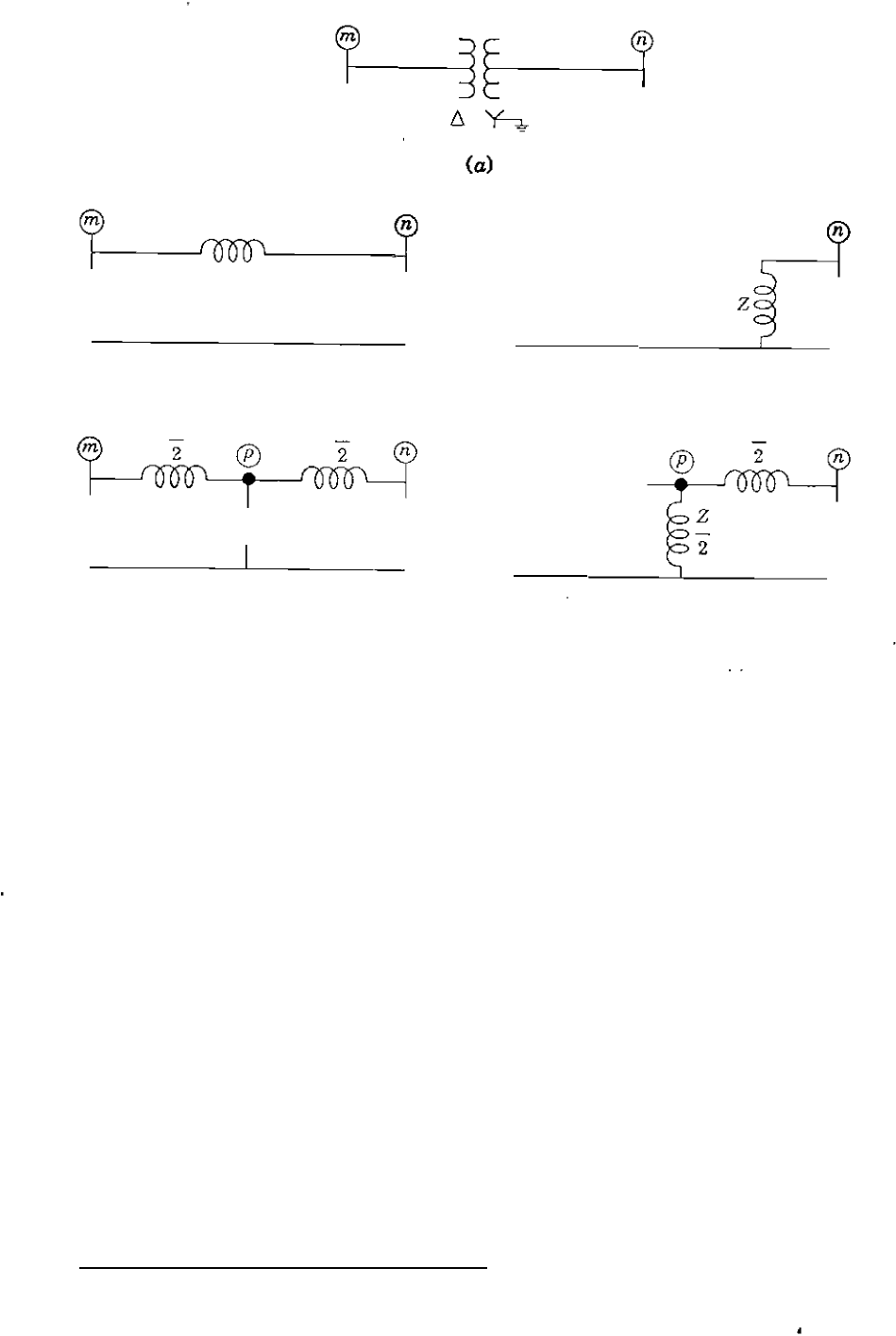
?
z
Reference
(b)
Z
Z
Reference
Cd)
FIGURE 12
�
12.1
UNSYMMETRICAL
FAULTS ON POWER
SYSTEMS
477
Z
Reference
(c)
Z
�
Reference
(e)
(a) 6-Y grounded transformer with I eakage impedance Z; (b) posItIve-sequence circuit;
(c) zero-sequence circuit; (d) positive-sequence circuit with internal node; (e) zero-sequence circuit
with internal node.
the matrices ZbIJs and zb22s in the usual manner-that is, by adding the negative
of the leakage impedance Z between buses and ® in the positive- and
negative-sequence networks. However, a similar strategy does not apply to the
zero-sequence matrix Zb
o
Js if it has been formed directly from the pictorial
represcntation shown in Fig. 12.3(c). Adding -
Z
between buses and ®
docs not remove the zero-sequence connection from bus ®. To permit uniform
procedures for all sequence networks, one strategy is to include an internal
node
®
, as shown in Figs. 12.3(d) and 12.3(e ).
1
Note that the leakage
impedance is now subdivided into two parts between node ® and the other
nodes as shown. Connecting -Z /2 between buses ® and ® in each of the
sequence circuits of Figs. 12.3(d) an d 12.3(c) will open the transformer connec
tions to bus ®. Also, the open circuits can be represented within the computer
algorithm by br
a
nches of arbitrarily large impedances (say, 106 per unit).
Intcrn al nodes of transformers can be useful in practical computer applications
ISee H. E. Brown, Solution of Large Networks by Matrix Methods, 2d ed., John Wiley & Sons, Inc.,
New York, 19R5.
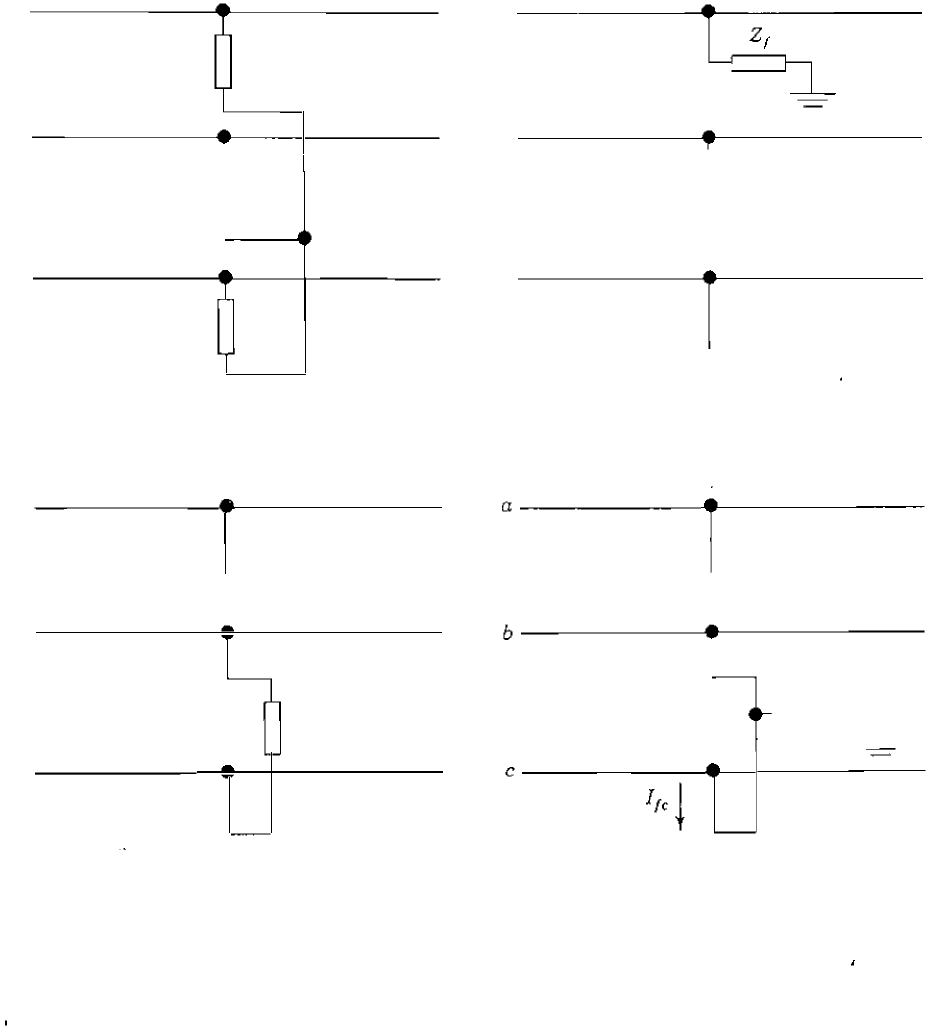
478 CHAPTER 1
2
UNSYMMETRICAL FAU LTS
of the
Z
bu
s
building algorithm. The reader is referred to the reference cited in
footnote
1
for further guidance in handling open-circuit and short-circuit (bus
tie) branches.
The faults to be discussed in succeedi ng sections may involve impedance
Zt between lines and from one or two lines to ground. When Zj
=
0, we have a
direct short circuit, which is called a bolted fa ult . Although such direct short
circuits result in the highest value of fault current and are therefore the most
conservative values to use when determining the eects of anticipated faults, the
fault impedance is seldom zero. Most faults are the result of insulator ashovers,
where the impedance between the line and ground depends on the resista nce of
a
a
I
r
a
t
Z
r
I
r
a
I
T
b
b
,
I
f
b
j
O
z
/
I
r
b
t
\
c
c
I
r
e
j
-
I
r
e
�
Z
r
(a) Three-phase fault
(6) Single line-to-ground faull
I
r
a
t
r
a
r
I
r
a
t
a
�
�
b
•
b�
I
r
b
t
i
r
b
�
Z
r
Z
r
-�
c
c-I
-
I
r
e
�
(c) Llne-to-line fault
Cd) Double line-lo-ground fault
GU 12.4
Connection diagrams of the hypothetical stubs for various faults through impedance.
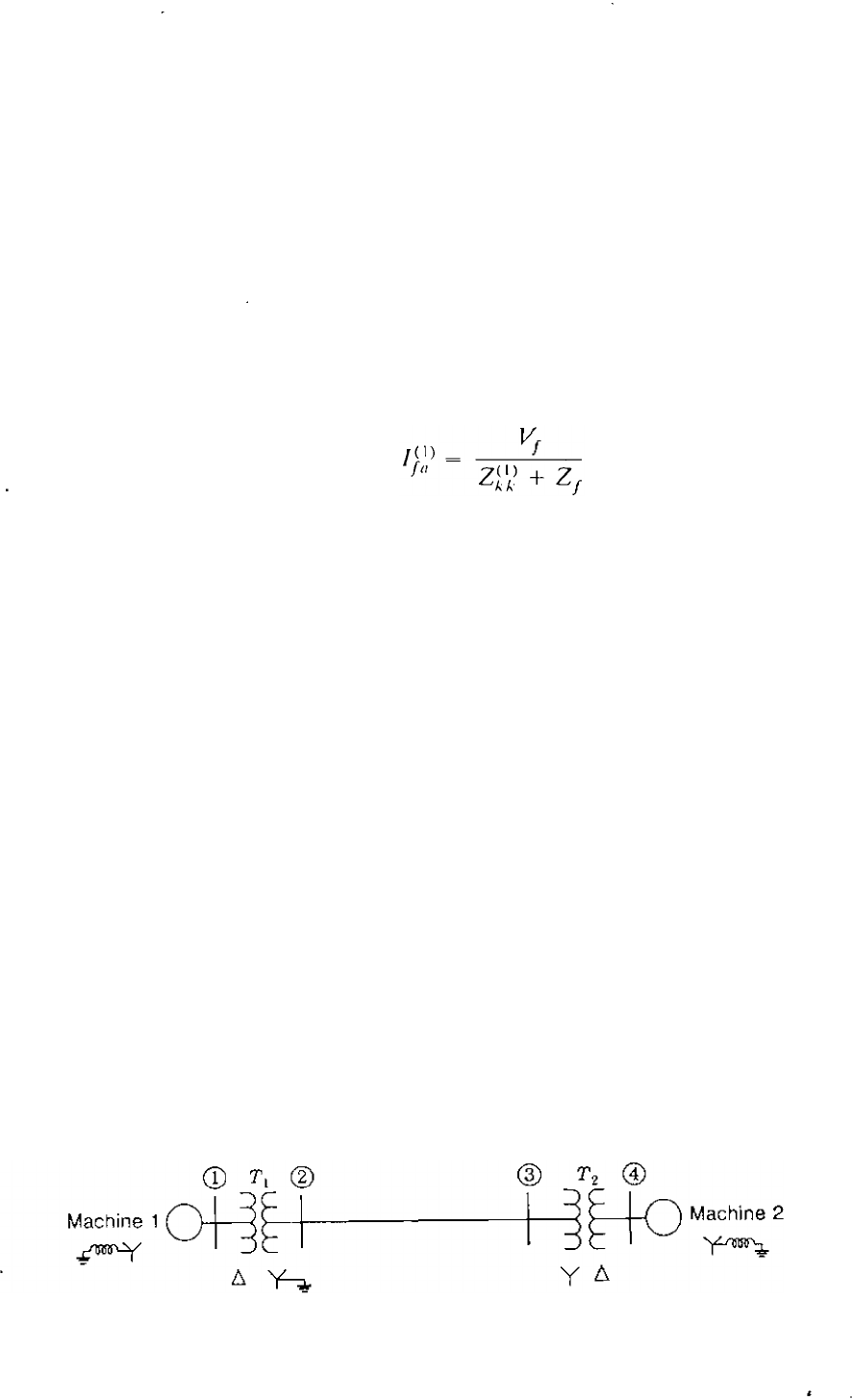
12.1 UNSYMMETRICAL FAULTS ON POWER SYSTEMS
479
the
arc, of the tower itself, and of the tower footing if ground wires are not
used. Tower-footing resistances form the major part of the resistance between
line and ground and depend on the soil conditions. The resistance of dry earth
is 10 to 100 times the resistance of swampy ground. Connections of the
hypothetical stubs for faults through impedance Z f are shown in Fig.
12.4.
A balanced system remains symmetrical after the occurrence of a three
phase fa ult having the same impedance between each line and a common point.
Only positive-sequence currents ow. With the fault impedance Z f equal in all
phases, as shown in Fig. 12.4(a), we simply add impedance Z f to the usual
(positive-sequence) Thevenin equivalent circuit of the system at the fault bus ®
and calculate the fault current from the equation
(
12.8)
Fur each of the other faults shown in Fig. 12.4, formal derivations of the
equations for the symmetrical-component currents
I}
�),
I}
;>' and
I
f;) are pro
vided in the sections which follow. In each case the fault point P is designated
as bus .
Example 12.1. Two synchronous machines are connected through three-phase
transformers to the transmission line shown in Fig. 12.5. The ratings and reactances
of the machines and transformers are
Machines 1 and 2: 100 MVA, 20 kV;
x;; = X
I
= X2 = 20%,
Xo = 4%,
Xn = 5%
Transformers T) and T2:
100 MV A, 20�/345Y kY;
X = 8%
On a chosen base of 100 MY A, l45 kY in the transmission-line circuit the line
reactances arc X
I
= X2 = 15% and X() = 50%. Draw c<lch of the three sequence
networks and find the zero-sequence bus impedance matrix by means of the ZhUS
building algorithm.
FIGURE 12.5
Single-line diagram of the system of Example 12.1.
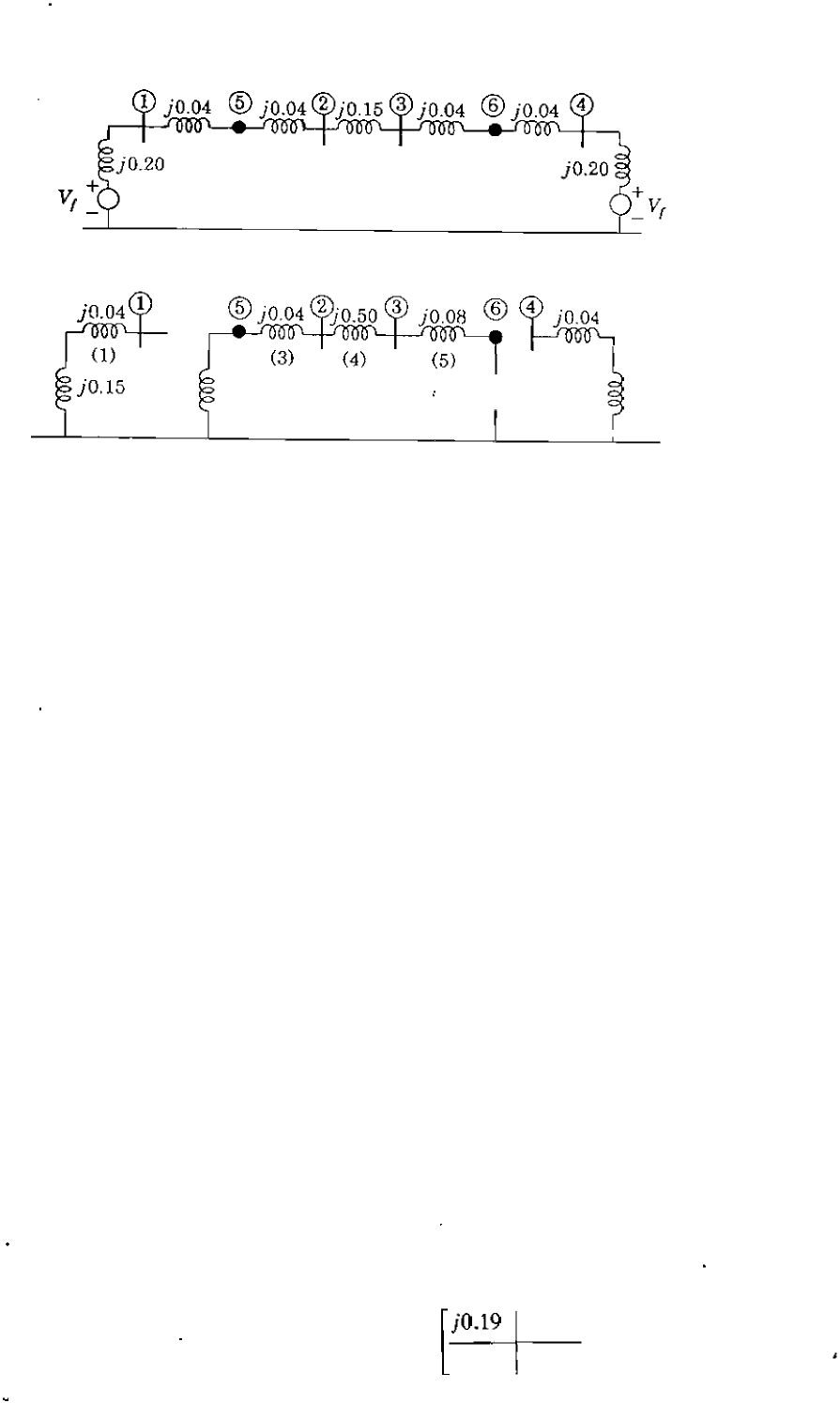
0 CHAPTER 1
2
UNSYMMETRICAL FAULTS
jO.04
(2)
Reference
(a)
Reference
(b)
®�
(6)
1
7
jO.15
GURE 12.6
(a) Positive-sequence and (b
) zero-sequence networks of the system of Fig. 12.5. Buses 0 and ®
are internal nodes of the transformers.
Step 1
Step 2
Solution. The given per-unit impedance values correspond to the chosen base, and
so they can be used directly to form the sequence networks. Figure 12.6(a) shows
the positive-sequence network, which is identical to the negative-sequence network
when the emfs are short-circuited; Fig. 12.6(
b)
shows the zero-sequence network
with reactance 3Xn = 0.15 per unit in the neutral connection of each machine.
Note that each transformer is assigned an internal node-bus
W
for transformer
T
J
and bus
®
for transformer T
2
• These internal nodes do not have an active role
in the analysis of the system. In order to apply the Zbus
building algorithm, which
is particularly simple in this example, let us label the zero-sequence branches from
1 to 7 as shown.
Add
branch 1 to thc rcfcrencc node
[jO.19]
Add branch 2 to the reference node
W
[jO.19
0 1
0
jO.04
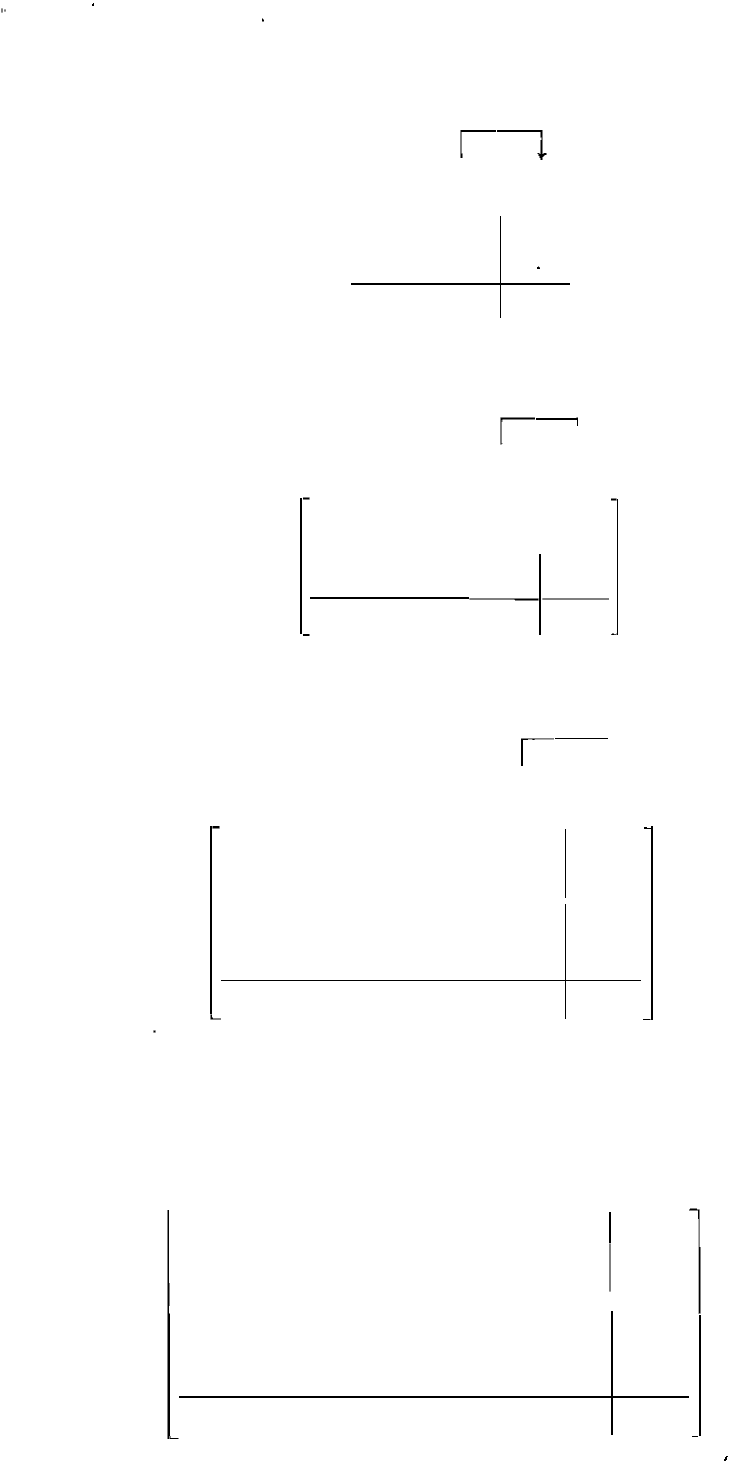
Step 3
Step 4
Step 5
12.1 UNSYMMETRICAL FAULTS ON POWER SYSTEMS 1
Add branch 3 beeen buses and @
I
!
@ 0
f
jO.19
0
jO
O
O4 j
[ 0
jO.04
0 jO
.
04 jO.os
Add branch 4 between buses
@
and
[
i
�
W
0
jO.19
0
0
0
w
0
jO.04
iO.04
iO 04
[0
()
iO.04
iO.OS
iO.OS
0
jO '()4
iO.OS
iO.5S
Add branch 5 between buses
and
®
I
@
®
jO.19
0 0 0 0
0
jO.04 jO.04
jO.04
jO.04
W
0
jO.04
jO.08 jO.08
jO.08
[0
0
jO.04 jO.08
jO.58
jO.58
®
0
jO.04 jO.08 jO.58
jO.66
Step 6
Add branch 6 from bus @ to the reference
© @
-
jO.19
0 0 0 0
0
0
jO.04
jO.04 jO.04
jO.04
0
0 jO.04
jO.08 jO.08 jO.08
0
0
0
jO.04
jO.08 jO.58
jO.58
0
®
0
jO.04
jO.08 jO.58 jO.66
0
@
0
0
0 0
0
jO.19

482 CHAPTER 12 UNSYMMETRICAL FAULTS
Buses and ® are the ctitious internal nodes of the transformers which
facilitate computer application of the Zbu
S
building algorithm. We have not
shown calculations for the very high impedance branches representing the open
circuits. Let us remove the rows and columns fo r buses
and
®
from the
matrix to obtain the eective working matrix
W
@
jO . 1
()
n
()
Z(O) -
W
0
jO.O�
jO .O
0
tHIS -
0
jO .OS
jO.58
0
@
0
()
0
jO .19
The zeros in Z��s show that zero-sequcnce current injectc intl! bus or bus
@
of Fig. 12.6(b) cannot cause voltages at the other buses bCuSC of the open
circuits introduced by the 6-Y transfo rmers. Note also that the jO.08 per-unit
reactance in series with the open circuit between buses
®
and
@
does not
aect Z��s since it cannot carry current.
By
applying the Z
bus
building algorithm to the positive- and negative
sequence networks in a similar manner, we obtain
Z(I) =
Z(
2
) =
b
u
s
b
u
s
W
®
@
jO.1437
jO.1211
jO.0789
jO.0563
W
jO.121 1
jO.0789
jO.1696 jO .1104
jO.1104
jO.1696
jO.0789
jO.121 1
We use the above matrices in the examples which fullow.
12.2 SINGLE LINE-TO-GROUND FAULTS
@
jO.0563
jO.0789
jO.1211
jO.l437
The single line-to-ground fault, the most common type, is caused by lightning or
by conductors making contact with grounded structures. For a single line-to
ground fault through impedance Zf the hypothetical stubs on the three lilies are
connected, as shown in Fig. 12.7, where phase a is the one on which the fault
occurs. The relations to be developed for this type of fault will apply only when
the
fault is on phase a, but this should cause no diculty since the phases are
la
beled arbitrarily and any phase can be designated as phase
a
. The conditions
at the faul t bus
®
are expressed by the following equations:
(1
2.9
)
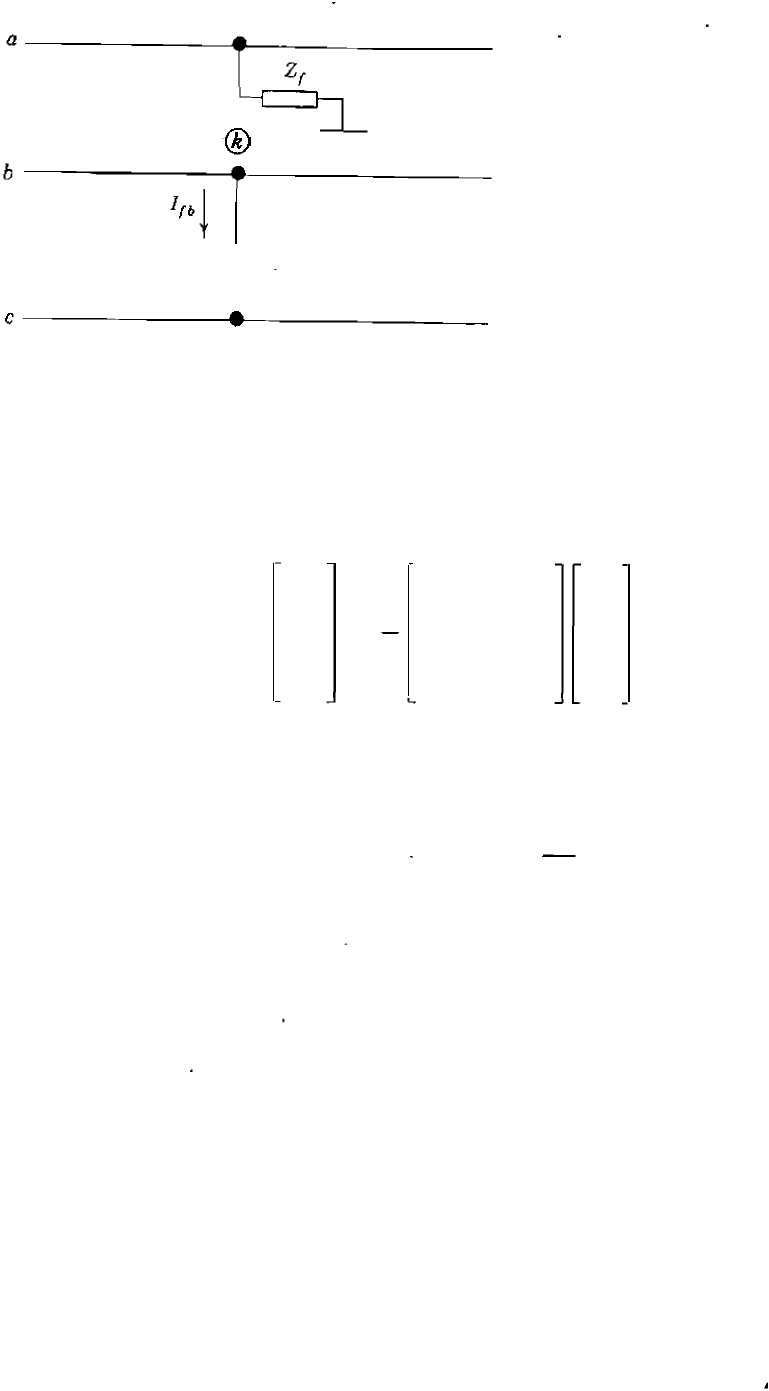
12.
2
SINGLE L1NE-TO-GROUND FAULTS 483
®
a
���
-
I
,
o
t
�
®
b
-
-I rb
{
r �-
®
FIGURE 12.7
c�.
_
I
r
,
�
I
Connection diagram of the hypothetical
stubs for a single line-to-ground fault. The
fault point is called bus .
With I
f
b
=
f
f
e
=
0, the symmetrical components of the stub currents are given
by
1
(
0
)
1
1
1
f
a
1
1
(
1
)
=
1 a
a
2
f
i
l
3
1(
2
)
f
a
1
a
2
a
and performing the multiplication yields
I
f a
1
(0
)
=
1
(1)
=
1(
2
)
=
f
a
Ja
f
a
3
I
f
a
0
0
(12.10
)
Substituting I}:�) fo r I
}
I
;) and 1/(;) shows that
I
f
a = 31
}
�:), and from Eqs. 02.7) we
ollLlin
v(O) -
ka
-
V
e
l
)
=
. 11
V
(2)
=
ka
-
Z
(0)
I
(0)
H
f
a
V -
Z
(
l
)
1(
0)
f
kk fa
-
Z(2) /(
0
)
kk fa
Summing these equations and noting that V
k
o
=
3Z
f
I
X
? give
(
12.11
)
v
=
V
(O) +
V
el) + V(2)
=
V -(Z{O) +
Z
{l) + 2(2))1(0) = 3
2
frO}
ka . 0 ka a f kk kk kk fa f fa
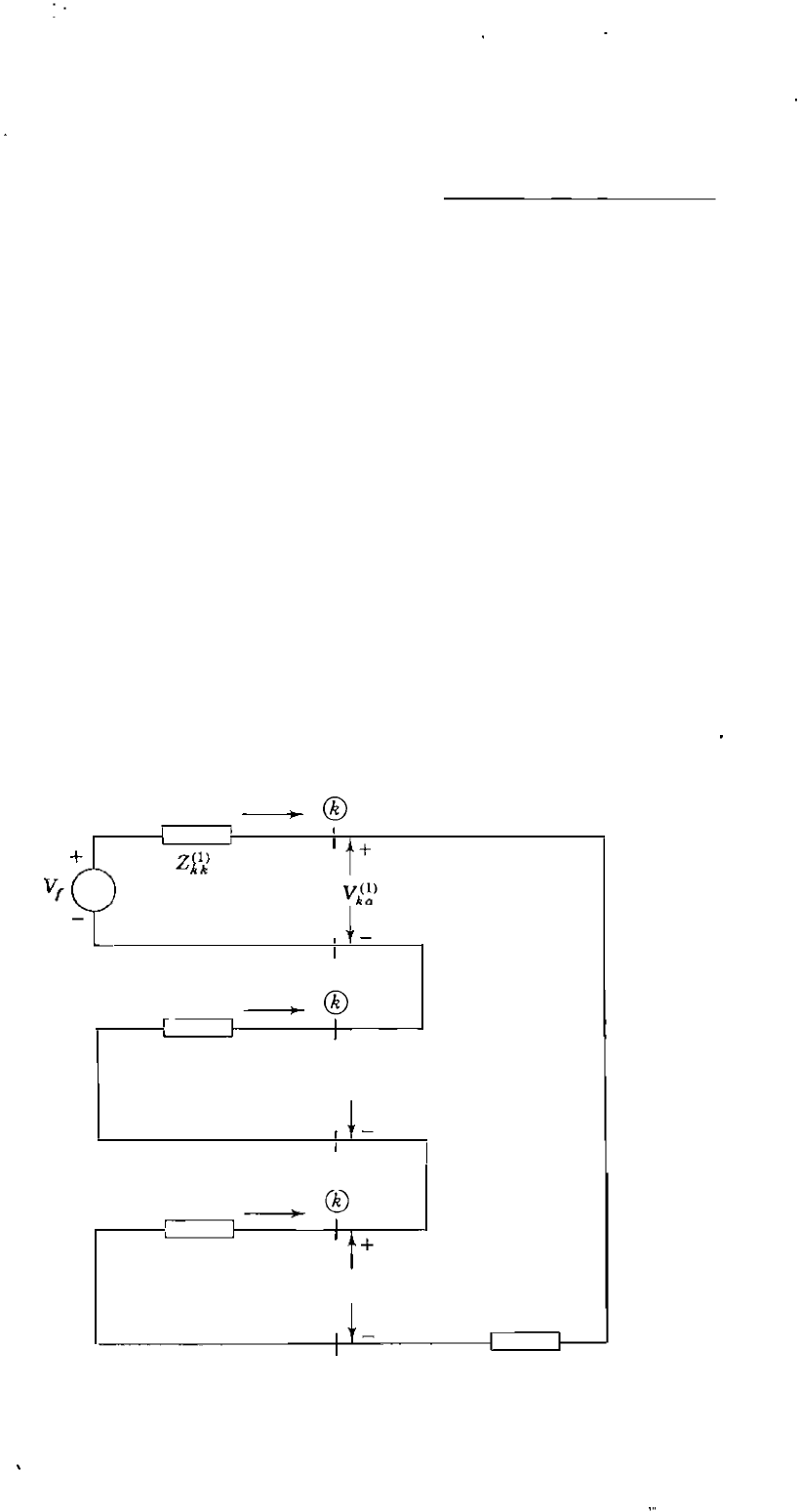
CHAER 1
2
UNSYMMETRICAL FAULTS
Solving for /
J
�) and combining the result with Eq. 02.10), we obtain
v
'
/
(0) =
/
(
1
) =
/
(
2
) =
f
f
a
f
a
f
a
Z(I) + Z(2) + Z(O) + 3Z
kk kk
kk
f
(12.12)
Equations 02.12) are the fault current equations particular to the single
line-to- ground fault through impedance Z f' and they are used with the symmet
rical-component relations to dete rmine all the voltages and currents at the fault
point P. If the Thevenin equivalent circuits of the three sequence networks of
the system are connected in series, as shown in Fig. 12.8, we see that the
currents and voltages resulting therefrom satisfy the above equations-for the
Thevenin impedances looking into the three sequence networks at fault bus
are then in series with the fault impedance 3Zf and the prcfaull vultage source
Vf ' With the equivalent circuits so connected, the voltage across each sequence
neork is the corresponding symmetrical component of the voltage
V
k
a
at the
fault bus ®, and the current injected into each sequence network at bus
® is
the negative of the cOfn;sponding sequence cu
- 2008 — 2025 «СтудМед»
